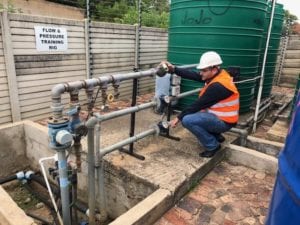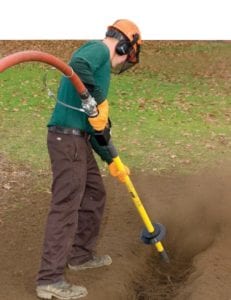Utility leak detection and pipeline condition assessment must form part of a continuous maintenance planning cycle. At this stage, however, few municipalities have effective assessment systems in place. IMIESA speaks to SA Leak Detection Distributors about its role in minimising technical water losses. It starts with water audit training.
 South Africa’s major cities are all undergoing significant expansion with a corresponding increase in the number of water users. This is exerting great pressure on scarce water resources, making the provision of new infrastructure a priority.
Cape Town’s drought and water crisis is one of the most talked about right now. The way the city is handling its current crisis is in the spotlight both locally and internationally since so many industries critical to the regional economy, like agriculture, manufacturing and tourism, depend on urgent responses to water security. For many, the interim solutions will include desalination and, potentially, wastewater reuse (at least for industrial applications), complemented in the longer term by conventional dam supply once water levels return to normal.
However, a more immediate priority is the pressing need to address technical water losses due to failed infrastructure. Simply put, unnecessary leaks are placing a major drain on our resources. They are also impacting negatively on municipal budgets due to resulting shortfalls in the water revenue tariffs traditionally used to help fund maintenance and new construction.
“It’s not just about finding leaks, though. It’s about embarking on a total audit assessment that covers every aspect of a bulk water reticulation system and then making sure that the necessary maintenance budgets, equipment and skills are in place to implement repair interventions,” says Tommy Tinkler, national sales manager for SA Leak Detection Distributors (SALD).
“Traditionally, our view is that water audits have focused more on consumption patterns rather than the underlying condition of the infrastructure. That needs to change urgently to halt the millions of litres being lost annually due to pipe leaks. The solution is to focus on continuous condition assessment monitoring. That’s where our technical expertise and OEM technologies come into play.”
South Africa’s major cities are all undergoing significant expansion with a corresponding increase in the number of water users. This is exerting great pressure on scarce water resources, making the provision of new infrastructure a priority.
Cape Town’s drought and water crisis is one of the most talked about right now. The way the city is handling its current crisis is in the spotlight both locally and internationally since so many industries critical to the regional economy, like agriculture, manufacturing and tourism, depend on urgent responses to water security. For many, the interim solutions will include desalination and, potentially, wastewater reuse (at least for industrial applications), complemented in the longer term by conventional dam supply once water levels return to normal.
However, a more immediate priority is the pressing need to address technical water losses due to failed infrastructure. Simply put, unnecessary leaks are placing a major drain on our resources. They are also impacting negatively on municipal budgets due to resulting shortfalls in the water revenue tariffs traditionally used to help fund maintenance and new construction.
“It’s not just about finding leaks, though. It’s about embarking on a total audit assessment that covers every aspect of a bulk water reticulation system and then making sure that the necessary maintenance budgets, equipment and skills are in place to implement repair interventions,” says Tommy Tinkler, national sales manager for SA Leak Detection Distributors (SALD).
“Traditionally, our view is that water audits have focused more on consumption patterns rather than the underlying condition of the infrastructure. That needs to change urgently to halt the millions of litres being lost annually due to pipe leaks. The solution is to focus on continuous condition assessment monitoring. That’s where our technical expertise and OEM technologies come into play.”
 In addition to the revolutionary Air-Spade®, the SALD product range includes leading brands like Sewerin®, JD7® and MiniCam®, and covers the areas of utility services location, leak detection and pipe inspection. Additionally, SALD is the master licensor for Nu Flow® pipe relining technology in Africa. “We also manufacture and supply our own epoxy for pipe rehabilitation and cured-in-place pipe lining (CIPP),” Tinkler explains. All products
In addition to the revolutionary Air-Spade®, the SALD product range includes leading brands like Sewerin®, JD7® and MiniCam®, and covers the areas of utility services location, leak detection and pipe inspection. Additionally, SALD is the master licensor for Nu Flow® pipe relining technology in Africa. “We also manufacture and supply our own epoxy for pipe rehabilitation and cured-in-place pipe lining (CIPP),” Tinkler explains. All productsare supported by SALD’s team of OEM-certified technicians. SALD is also believed to be the only company in South Africa providing a rental service for ground-penetrating radar and leak detection equipment.
Training deficiencies and zones
“One the biggest problems is the lack of planning when it comes to infrastructure maintenance, plus poor training,” Tinkler continues. “We’re helping to address this.” Housed at its head office in Benoni, SALD’s training centre caters for specialists employed in water departments at local, district and metropolitan municipalities, as well as consulting engineering personnel. “Since the two disciplines interface in terms of advisory and implementation functions, it’s important that they have an in-depth understanding of how the technology works in order to conduct effective water audits,”Tinkler continues. During advanced training, SALD shows candidates how to create zones; gain an in-depth understanding of flow and pressure; and successfully apply appropriate technologies, such as acoustic or gas detection. At the training centre is a network of ‘underground leaks’ that are electronically controlled: they can be turned on and off to simulate an actual failed pipeline section. At the moment, SALD uses borehole water for this purpose, but has recognised the need for more eco-friendly practices. The plan is to adopt the approach used by OEMs like Sewerin where audio speakers are embedded into the ground to simulate leaks by transmitting sound waves. These are received and interpreted by handheld detection equipment on the surface.

SeCorrPhon AC 200 – Correlator and acoustic water leak detector combined / professional – flexible – intelligent
every leak.”
Air excavation
Having established a zone, the area’s water losses and the type of maintenance interventions required can be determined. The next step is to gain access to the buried pipeline section needing repairs. Here, the proprietary Air-Spade® product, which employs air excavation techniques, is one of the most effective tools available because it’s totally non-destructive. In Australia, for example, air excavation is a mandatory practice required by the country’s National Utility Locating Contractors Association (NULCA). In South Africa, however, SALD believes this practice is still seriously underutilised. Within the range, the Air-Spade® 3000 is the most powerful, non-destructive, compressed-air-powered excavation tool available on the market today. “An experienced operator can easily excavate a 2 m deep hole in 10 minutes within a perfectly controlled environment, adding extensions as necessary to go down deeper,” explains Tinkler. The Air-Spade® is normally used in conjunction with the Air-Vac® truck/trailer system, which vacuums up the dirt, sand, rocks, or water during the excavation. The Air-Vac® can be mounted on the back of a truck or trailer.Projects
In addition to the courses provided at its Benoni training centre, SALD also offers in-field training. A recent example is the supply of equipment and training to Re-Solve Consulting, and Engineering Advice and Services, who are conducting a series of audits in Port Elizabeth as part of Nelson Mandela Bay’s drought intervention initiatives. “There needs to be a balanced approach to infrastructure maintenance and upgrades. Since municipal budgets are constrained, it doesn’t make sense to spend money unnecessarily,” Tinkler continues. Municipalities often replace entire systems because of a few failures – largely due to a lack of understanding about condition assessment monitoring. “Let’s fix what we have first and, if the pipeline is still stable, rather focus on extending its life in the medium term. The exception would be for bulk water trunk line projects supporting new developments. “The important thing to emphasise is that leak monitoring and assessment has to be continuous if South Africa is going to achieve sustainable results. As consumption demand keeps increasing, so too will the pressures and flows,”Tinkler concludes.








